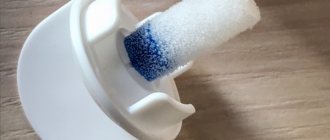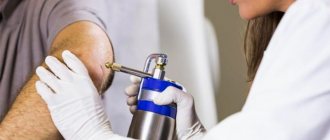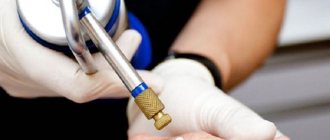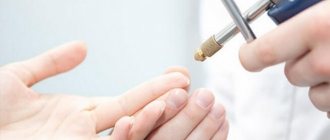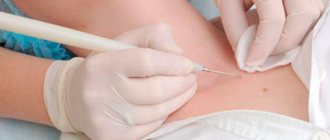Treatment of alopecia areata with cryotherapy
The content of the article
For focal alopecia, superficial freezing using the deep “Deep steak” method, contact method or spray method is used.
Freezing a swab immersed in liquid nitrogen combined with pressure is done by rolling it over the skin for about 5-7 seconds. Freeze by contact or spray method for 5-10 seconds. once or twice. Cryotherapy is repeated 1-2 times a week in 4-8 week cycles or every other day 15 times per cycle.
Treatment of alopecia areata with cryotherapy
The cycles should be repeated four times with monthly breaks. The results of cryotherapy for alopecia areata are encouraging. However, the procedures should be carried out very carefully, because even a short-term excessive drop in temperature can damage the hair follicles. So the “Deep steak” method remains the safest. You can also freeze areas of baldness with ethyl chloride 2 times a week (regrowth takes place after about 10-12 freezes).
Recommendations after cryomassage
For 7 days after the procedure, it is recommended to avoid direct sunlight - it is for this reason that this manipulation is not recommended for summer. If you need to go outside, you need to wear a hat with a brim so that the skin of your face is in the shade. It is not recommended to use foundation during the week; you can only use moisturizers with SPF of at least 20.
Within 2-3 days after the procedure, slight peeling of the skin is possible; this is an absolutely normal reaction of the body to exposure to cold. After the specified time, all inconveniences disappear on their own.
Cryotherapy for acne vulgaris and rosacea
For acne vulgaris and rosacea, pustular, papular and larger cysts are suitable for cryosurgery. Blackheads cannot be treated with cold.
Best results are achieved using the 2-5 second spray method for small and superficial lesions, up to 5-20 seconds for larger cysts. Shallow lesions and cysts on the skin of the torso and chest respond best to treatment.
Using the Spray Method to Treat Acne Vulgaris and Rosacea
The same thing happens with rosacea. In the case of nodular changes in the nose (rhinophyma), due to their significant blood supply, in order to achieve sufficiently deep necrosis, it is necessary to spray the drug for about 20-40 seconds or repeat the treatment after two months. The mechanism of action of cryotherapy for acne is to cause atrophic changes in the skin appendages.
Types of cryotherapy in a beauty salon
- A separate type of cryotherapy is a procedure for eliminating acne. Liquid nitrogen is applied to the affected skin using a special wooden spatula and kept on the skin for a certain time.
- If there are formations on the skin that are more serious and persistent than acne, then cryodermabrasion is used to remove them. This procedure is characterized by exposure to ultra-low temperatures and removal of the upper layers of the epidermis.
- Warts are removed in beauty salons and dermatological clinics by cryodestruction. The essence of the procedure is that a small area of skin affected by warts is exposed to cold. The result is destruction of the treated integumentary tissue.
- Aerocryotherapy is a restorative procedure that involves blowing cold air onto the skin. It is usually prescribed after plastic surgery.
- Also in beauty salons, cryolipolysis is used - this is a procedure that removes deposits of adipose tissue.
Choosing the type of cryotherapy that is right for your skin is extremely difficult on your own. Before doing the procedure, be sure to consult with a specialist and diagnose the skin on your face. After this, the cosmetologist will tell you what type of cryotherapy in a beauty salon is best for you to use.
Treatment of granuloma annulare with liquid nitrogen
Treatment of granuloma annulare, which consists of freezing with ethyl chloride or snow paste, has been used for a long time. Spraying with liquid nitrogen for 20-30 seconds is less commonly used. Treatment can be repeated after 4 weeks. For lesions with a diameter of more than 3 cm, it is sufficient to freeze only the peripheral part. Rashes in the form of disseminated granuloma annulare cannot be treated with cryosurgery.
Granuloma annulare
For nodular prurigo, cryosurgical treatment results in rapid resolution of the lesions. The best effect is achieved when using applicators with a diameter corresponding to the size of the nodules, with double freezing in 15-45 seconds. However, the results of treatment are not permanent. The itching usually recurs after a few months.
Localized scabies is indicated for treatment by spraying the product repeatedly and freezing the surface without blistering, which results in short-term relief of symptoms and easier lesions.
Cryotherapy for lupus erythematosus
In lupus erythematosus, cryotherapy is particularly useful in treating the discoid form (DLE). The method can be used several times, with an interval of 7-14 days, lasting 2-5 seconds. Freezing is carried out with solidified carbon dioxide in the form of sticks or a mixture with ether or gasoline.
Liquid nitrogen is used less frequently.
Double freezing using the spray or contact method for 15-60 seconds also gives good results. Freezing too shallow promotes relapses. In large lesions with active lesions along the periphery, it is preferable to freeze only the marginal part with a spray.
Cryotherapy for DVE may be an alternative to intralesional corticosteroid injections, reducing itching and leaving flat, discolored scars. In some patients, this may prevent the development of tumors in the lesions.
Other indications for the use of cryotherapy methods in dermatology include: Mibelli porokeratosis, lichen sclerosis and atrophic lichen, cirrhosis of the penis, Passini-Pierini atrophoderma. and etc.
Cryosurgery is also used for the removal of ingrown toenails, tattoo removal, some tropical mycoses, cutaneous leishmaniasis, larva migrans infections, psoriasis, and the treatment of purulent skin conditions such as boils, carpal furuncles, strokes, and abscesses.
Types of cryoprocedures
Cryotherapy today is actively used to rejuvenate and improve facial skin. Cold treatment of tissues has a complex effect on healthy and pathological cells. An experienced specialist will help you choose the necessary cryotherapy technique to solve specific problems and achieve your goals.
The main types of cryoprocedures:
- Cryomassage. Short-term exposure of the skin to liquid nitrogen increases blood circulation and metabolic reactions, is used to accelerate the regeneration process, stimulate hair follicles, and in the treatment of alopecia and skin diseases.
- Cryodermabrasion. The technique is based on the destruction of the upper keratinized layer of skin, which interferes with proper nutrition and blood circulation of the tissue. The method is also used to eliminate scars and post-acne.
- Cryodestruction. This method involves freezing the skin in the area of pathological tumors using low-temperature liquid nitrogen. After the procedure, pathological tissues are necrotic and removed without visible defects.
- Cryolipolysis. This technique is used to remove excess fat deposits in the face and body.
- Cryoelectrophoresis. Using low-intensity electric current, specialists inject low-temperature medicinal compounds into the tissues. This allows you to reduce age-related changes, stimulate collagen, strengthen the skin frame, improve complexion and cope with common problems, including seborrhea and acne.
- Aerocryotherapy. The technique involves treating the skin of the face with a stream of cold air after a chemical peeling procedure, tissue polishing using laser machines, or plastic surgery. Aerocryotherapy is used to reduce pain, speed up the recovery process and relieve swelling.
The specific type of facial cryotherapy should be selected by a qualified specialist, analyzing the general condition of the patient, skin characteristics, and the presence of certain concomitant disorders. Cold exposure has a rejuvenating effect on cells. But the technique can only be used taking into account possible contraindications and after preliminary consultation with a competent cosmetologist.
Contraindications to cryotherapy
When qualifying patients for treatment with this method, numerous general and local contraindications should be taken into account.
- The coexistence of pathological formations, the exacerbation of which can be caused by local temperature changes:
- cryoglobulinemia;
- cryofibrinogenemia;
- cold agglutinin disease;
- cold erythema;
- inflammation of the subcutaneous tissue from cold;
- Raynaud's disease.
Cold erythema
2. Diseases and treatment procedures that prevent proper healing after freezing:
- connective tissue diseases and autoimmune diseases,
- multiple myeloma,
- thrombocytopenia,
- agammaglobulinemia,
- pyoderma gangrenosum,
- immunosuppressive treatment,
- dialysis therapy.
Taking into account the localization, it is not recommended to perform cryosurgery for changes:
- on the lower leg - due to prolonged healing,
- on the free edge of the wings of the nose and at the border of the labial red (especially the upper lip) - due to the risk of unsightly scars (this mainly applies to cases requiring deep freezing),
- into the ear canal - due to the risk of facial paralysis.
How cryotherapy works in a beauty salon: the main stages of the procedure
Cryotherapy in beauty salons and beauty salons is carried out in several stages:
- First, the patient is required to undergo a comprehensive examination by a cosmetologist, the purpose of which is to exclude the presence of contraindications to the procedure. The specialist must also choose the type of cryotherapy and draw up a work plan.
- At the second stage, the skin is prepared for the main procedure.
- Next, the patient is given local anesthesia and waits for the effect of the drug to appear.
- When the anesthesia has taken effect, a special mixture is applied to the skin in a thick layer. It is hypoallergenic and has no contraindications, perfect for any skin type.
- Liquefied nitrogen is applied on top of this product using a specialized nozzle.
- After cryotherapy is completed, the skin is treated with moisturizing and caring creams.
- The specialist must assess the patient’s condition and give him the necessary instructions.
The cryotherapy procedure in a beauty salon lasts a maximum of 20 minutes, and its effect lasts for several years.
Most experts believe that rehabilitation is not necessary after cryotherapy. Therefore, patients are not given sick leave. Also, after the procedure there is no need for repeated visits to the beauty salon. It is only important to remember that for a whole week after cryotherapy, large amounts of decorative cosmetics and creams that will clog the pores should not be applied to the skin.
It is also not recommended to stay under the scorching sun for a long time, expose the body to excessive physical stress and visit the sauna. After skin restoration, patients can return to their normal lives. Rehabilitation after cryotherapy in beauty salons lasts differently for each patient: for some, 3 hours, for others, more than a week.
In what situations is the help of a cosmetologist needed?
As a rule, cryotherapy occurs without consequences and does not cause side effects. But there are still cases when you will have to seek the help of a specialist, and urgently:
- The appearance of severe swelling on the face and dark blue circles under the eyes.
- Uncomfortable sensations on the skin: itching, irritation and red spots.
- Increased body temperature not associated with any disease.
- Appearance of scars.
- Excessive dryness of the skin.
In these cases, additional treatment will be required, which will be prescribed by a cosmetologist in a beauty salon.
Read material on the topic: Laser facial skin rejuvenation: useful tips and recommendations
Side effects and complications after cryotherapy
Their occurrence and severity depend on the depth of freezing, the location and size of the treated lesion.
Complications after cryotherapy are divided into:
- immediate;
- early;
- late;
- permanent.
Most direct reactions are always occurring phenomena. Their unexpected intensity should be cause for concern.
Immediate complications:
- Pain (17.8%) - can occur with any treatment, even when using the stick method. Re-freezing usually causes less discomfort. The pain intensifies during defrosting and can last up to several hours. It's like an aching ripple. Particularly sensitive areas are: fingertips, nail shafts, soles, ears, helix of the ear, lips and mucous membranes, temporal and frontal areas (due to the ease of irritation of the periosteum);
- Edema (7.9%) is considered a side effect if it affects the tissue surrounding the treated lesion and is negatively assessed by the patient. The area around the eyelids is most susceptible; After treatment of lesions in this area, swelling may appear in the upper cheeks, nose, forehead and front of the scalp. Other vulnerable areas: lips, foreskin, labia, especially small ones. Swelling after cryotherapy procedures is more common in children;
- Bleeding - may occur after cryotherapy with applicators covered by highly perfused vascular or cancerous granuloma nodes. There is also a risk of bleeding when treating lesions that have previously been biopsied or if part of the tumor has been cut before surgery;
- Excessive reaction in the form of blisters - especially painful when the soles are affected;
- Gas penetration into the subcutaneous tissue occurs in exceptional cases when ulcerative tumor foci are frozen by spraying or with a fresh biopsy defect, especially in the lower eyelids. It occurs with a characteristic “crackling” of exfoliating tissues;
- Fainting - most often occurs in young people as a neurovegetative reaction with a drop in blood pressure and increased sweating (especially if the procedure was performed with the patient in a supine or supine position);
- Infection after surgery - the greatest risk of secondary infection occurs in the case of difficult-to-heal ulcers after treatment of lesions located on the lower legs. Prevention of this type of complication involves irrigating the lesions with hydrogen peroxide, applying topical antibiotic dressings, or using antibiotics in general (especially after treating multiple lesions, such as actinic keratoses);
- Feverish reaction.
Feverish reaction
Other rare complications: cardiac arrest, formation of vascular granuloma at the site of freezing, etc.
Early complications:
- Post-inflammatory color changes (0.5%) - appear mainly in people with dark complexions. They may cover the entire freeze field equally or appear as a discolored field border. They are an epidermal symptom - a decrease in the number of melanocytes after cryotherapy is accompanied by their functional hyperactivity. The discoloration disappears after a few months;
- Milia (12%) - some patients have many of them around the perimeter of the freezing field.
Late complications:
- Nerve Damage—Cryosurgical procedures cause reversible impairments of pain, touch, and cold sensation that may persist for several months depending on the location of the affected area. These disorders last the longest and are most pronounced in scars on the trunk and limbs. Motor fibers may also be damaged after treatment at the superficial nerve site. Particular care is required when treating lesions located on the lateral surfaces of the fingers, in the area of the angle of the jaw, in the jaw area, on the lateral parts of the tongue, in the fossa, on the back of the foot. The risk of nerve damage is reduced by using an anesthetic and folding the skin during freezing;
- Vascular granuloma;
- Pseudomalignant scar hyperplasia (1.3%) is a rare phenomenon that usually occurs after treatment of cancerous tumors or ulcers complicated by secondary bacterial infection. At the base of the atrophic scar, a dark red, linear, cohesive, raised body gradually grows, which may resemble a relapse. Places prone to this type of complications are: wings of the nose, upper lip (risk of disfigurement, tightening scar, especially after deep freezing), forehead, bridge of the nose, skin of the sternum, lower eyelid (risk of partial eversion of the eyelid). In exceptional cases, a keloid may form in the scar.
Permanent complications:
- Atrophic scar (2.7%);
- Eversion of the eyelids;
- Alopecia - deeper freezing of changes on the scalp causes persistent alopecia due to the high sensitivity of the hair follicles to low temperatures. Therefore, for cryosurgery it is necessary to carefully select lesions located along the edges of the hair on the forehead and temples, in the eyebrow area and on the skin of the chin in men;
- Color changes (6.9%) - their intensity depends on the duration of freezing. After approximately 6 months, re-pigmentation depends on the migration of melanocytes from the periphery. At this time, it is necessary to apply UV protection measures.
Despite the possible occurrence of the complications described above, cryosurgery still remains the method of choice for the treatment of many diseases in dermatology. Its undoubted advantages:
- relatively low cost of treatment;
- a small percentage of side effects;
- usually does not require anesthesia;
- fast healing;
- very good cosmetic effects;
- the possibility of use in areas that are less accessible to other treatment methods or that are a contraindication to their use;
- the possibility of re-treatment and use in case of ineffectiveness of other treatment methods.
Cryotherapy should be considered as a safe, effective, technically fast and simple method of treatment, allowing the treatment of many dermatoses and a large number of patients in an outpatient setting.
What effect does cryotherapy give in a beauty salon?
So, cryotherapy in a beauty salon is a physiotherapeutic procedure that promotes renewal and regeneration of the cellular composition of the skin. It is carried out through treatment with low temperatures, to which an immediate reaction occurs in the upper layers of the epidermis.
The procedure uses two main modes:
- Low, in which the skin is cooled to -70 °C. This operation is suitable for young people.
- Ultra-low is used for older clients whose skin is already noticeably wrinkled, while the skin is cooled to -130 °C.
Cryotherapy in beauty salons is actively used both separately and in combination with other dermatological and cosmetological procedures. After it, the effect of applying masks, wraps, and injections is greatly enhanced. Also, cryoapplications well consolidate the results of therapeutic or cosmetic effects. Cryotherapy eliminates many side effects from other procedures: inflammation, swelling, pain. This is especially important after plastic surgery, peeling or cleansing of the skin, or laser hair removal.
Cryotherapy also has a rejuvenating and restorative effect not only on the dermis, but also on the entire body. Cold accelerates tissue repair mechanisms and triggers immune reactions.
Effects of cryotherapy:
- Anti-inflammatory. It is associated with the transition of fluid from cells into the vascular cavity (reducing swelling), weakening the activity of inflammatory factors (decreasing body temperature and hyperemia), increasing cellular regeneration.
- Anesthetic. Cryotherapy “freezes” the pain receptors of the skin, regulates vascular tone and breaks the chain reaction “pain – spasm of muscle fibers – pain”. Thanks to this procedure, you can significantly relieve or relieve pain even with deep and massive burns, inflammatory processes, severe swelling, and allergies. It is important to remember that hormonal medications, if the patient is taking them, must be discontinued.
- Regulating muscle tone. This property of cryotherapy is valued above all others. With the help of low temperatures you can both reduce and increase the tone of muscle fibers. Moderate exposure to cold gives muscles strength and endurance. To relax muscle tissue, you need to influence it with ultra-low temperatures. When exposed to extreme cold, neuromuscular transmission is inhibited and muscles relax.
- Acceleration of metabolism. The body gets trapped and takes cryotherapy for the onset of winter, as a result of which it changes the metabolism and speeds up the breakdown and absorption of carbohydrates.
- After cryotherapy in a beauty salon, the skin becomes firmer, smoother and more refreshed. The regenerative effect of the procedure is extremely in demand in the treatment of various injuries, burns, trophic ulcers and other diseases.
- Cryotherapy has a beneficial effect on sleep and improves the mood of patients. It helps relieve stress (including in a state of hangover or withdrawal symptoms), invigorates, charges with new strength and rejuvenates the body.
- Cryotherapy stimulates the immune system and helps normalize hormonal levels (this is especially important in the treatment of impotence, hypothyroidism and a number of other diseases).
Cryotherapy is rightfully considered one of the most important and evolutionary medical procedures. This method allows you to effectively fight many diseases. The combination of stress simulation for the body's hormonal-regulating mechanisms, systemic improvement of blood circulation throughout the body, acceleration of metabolic processes and regeneration gives amazing results.
Cryotherapy in beauty salons is also often used to reduce body weight and normalize skin type.
Recommended articles on the topic:
- Facial mesotherapy procedure: pros and cons
- Beauty injections: types of drugs, reviews
- Placental therapy is the secret of eternal youth
Sources
- Markevich T.: Indications for the use of cryotherapy, 1994;
- Kanmerovsky M.: Cryosurgery for skin diseases, 1997.
- Bembenek M., Zhaka M.: Cryosurgery in the palliative treatment of malignant melanoma, 1997;
- Broniarczyk-Dila G., Janowski P.: Cryotherapy and its use in skin diseases, 1997;
- Jakubiak A.: Use of cryotherapy in the treatment of certain skin diseases, 1990;
- Kashuba A. et al. Cryotherapy with nitrous oxide in dermatological practice, 1995;
- Lis A. et al.: The influence of cryo-application time using liquid nitrogen on the effectiveness of treatment of basocellular epithelioma, 1997;
- Machonko T et al.: Treatment of alopecia areata with liquid nitrogen, 1981;
- Shmurly V. et al.: Cryosurgery. Methods and Applications, 1989.
ONLINE REGISTRATION at the DIANA clinic
You can sign up by calling the toll-free phone number 8-800-707-15-60 or filling out the contact form. In this case, we will contact you ourselves.
Advantages of the technique
Facial cryotherapy does not require general anesthesia and is a worthy alternative to traumatic surgical operations. Main advantages of the method:
- rejuvenating effect;
- strengthening blood circulation and tissue metabolic processes;
- safety of the procedure;
- no age restrictions.
With the correct use of liquid nitrogen, it is possible to solve many cosmetic problems, improve the general condition of the skin, and slow down the development of acne and acne.


